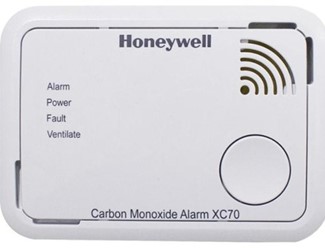Carbon monoxide detectors – Honeywell
Carbon monoxide detectors – Honeywell: heating season begins soon – think carbon monoxide and protect yourself in time
Carbon monoxide is a colorless, odorless, and tasteless gas that is lighter than air. It is formed by incomplete combustion of carbon-containing substances. In households, it occurs when operating gas boilers or burning wood in a fireplace or stove. It can also be found in car exhaust, which is a problem when the car engine is allowed to warm up in a closed garage in the winter months.
Although carbon monoxide poisoning most often occurs in the winter months, it is important to note that gas can also be generated in the summer months.
The consequences of the action of carbon monoxide depend on its concentration in the air and on the length of its exposure. Mild symptoms of carbon monoxide poisoning include headache, fatigue, nausea and weakness, and in severe cases there is loss of consciousness with possible respiratory and cardiac dysfunction and muscle spasms.
The CO concentration is expressed in parts per million (ppm). Thus a concentration of only 0.04% or 400 ppm CO can be lethal if a person is exposed to gas for a long time. Concentrations above 1% (10,000 ppm) will knock the person unconscious after just a few breaths, and death occurs within minutes.
Many people confuse the symptoms of carbon monoxide poisoning with the symptoms of the flu or cold. Possibility of poisoning exists if:
- several people in a joint household feel sick when they stay in the house for a long time
- you feel better outside the home
- the symptoms worsen or appear when the heater is switched on
- symptoms occur when the space is not ventilated or irradiated
To prevent carbon monoxide poisoning, it is necessary to pay attention to changes in the operation of the gas appliance, damage or unusual sounds. It is also necessary to ventilate the premises while using gas appliances. In addition, once a year it is advisable to call a chimney sweeper to inspect and clean the chimneys and an authorized service technician to service the heating and ventilation systems.
Carbon monoxide detectors – the most effective form of protection
In addition, the purchase of a carbon monoxide detector is recommended. which is also the only way to detect a dangerous concentration of CO in the air in time. That device can save your life. It will sound an alarm when the CO concentrations in the room reach higher than permitted levels, thus letting you know that it is necessary to leave the room you are staying in immediately and that it is necessary to check in the near future devices you suspect could be a source of that dangerous gas.
